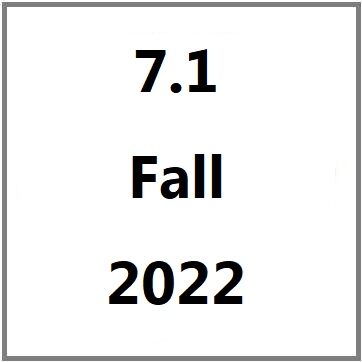Metaphoric Images as Carework: Teaching Writing Courses During the Pandemic
Peaches Hash, Ed.D.
Keywords: teaching, art, self-care
Categories: Revisionings of Teaching, Facilitation, and Professional Leadership; Visual, Sonic, Tactile, Interactive Texts as Self- and Collective Care
When my university moved all classes online during the spring 2020 semester, I was distraught. I teach undergraduate Rhetoric and Composition courses that are required for the university’s General Education program. Before the pandemic, I discovered that arts-based pedagogy could create, as bell hooks (1994) would describe, pleasurable spaces for student learning where students could take creative risks, actively learn, and express themselves; however, once I learned that my courses would move online, I no longer had a clear vision for how my arts-based curriculum could be effective. It definitely took some trial and error, but through remote arts-based activities, I noted some surprising developments in student expression (Hash, 2020; Hash, 2021).
Despite some success, I was exhausted and not looking forward to more semesters of teaching online. As a way to process my experiences, I decided to compose a metaphorical story with images. Through this format, I sought to blend the factual and imaginative worlds (Romano, 2000) in order to connect to a wider audience. From my research, I knew that creative methods of composing my experiences could help me as a writer see the world differently and prompt me to “discover new relationships and how they might be articulated” (Berthoff, 1981, p. 7). Additionally, I hoped that writing in metaphor could move my composition from a narrative about my specific experience teaching writing into something that could potentially “cross divides [and] make connections between [myself] and others” (Greene, 1997, p. 391). During a time when I felt extremely isolated, I suppose I desired to create something that would represent my new relationship to myself and my surroundings (Helmers & Hill, 2004) in a remote environment. Below is my finished product.
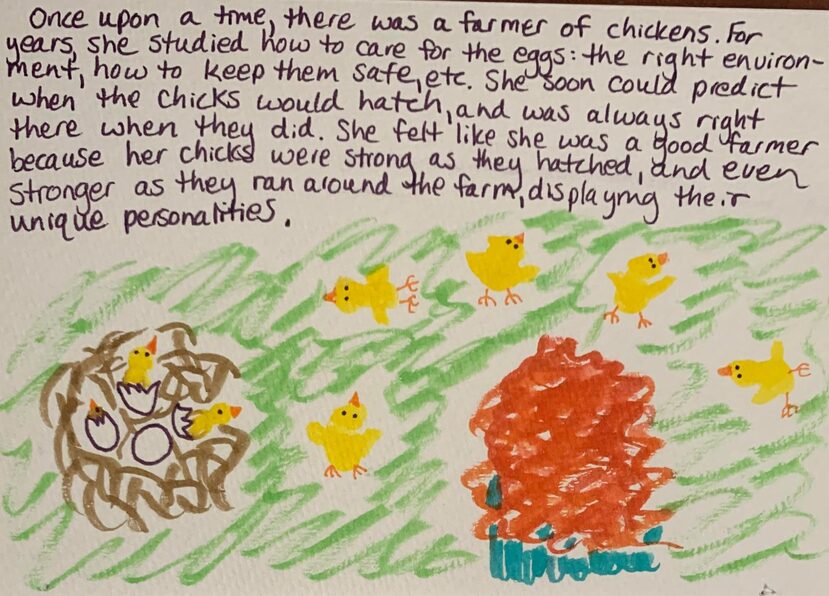
Image description: Human figure with long red hair and back towards the reader staring at baby chicks hatching from eggs in front of a green background. Handwritten text: Once upon a time, there was a farmer of chickens. For years, she studied how to care for the eggs: the right environment, how to keep them safe, etc. She soon could predict when the chicks would hatch, and was always right there when they did. She felt like she was a good farmer because her chicks were strong as they hatched, and even stronger as they ran around the farm, displaying their unique personalities.
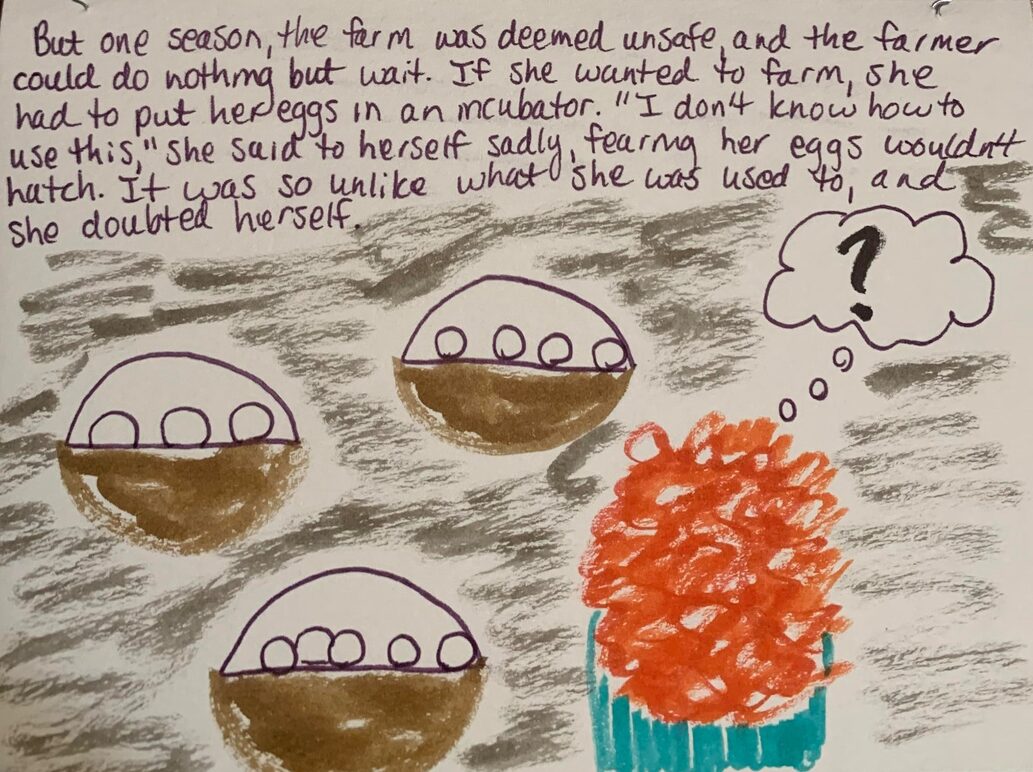
Image description: Human figure with long red hair and back towards the reader staring at eggs in incubators in front of a gray background. A thought bubble with a question mark comes from her head. Handwritten text reads, But one season, the farm was deemed unsafe, and the farmer could do nothing but wait. If she wanted to farm, she had to put her eggs in an incubator. “I don’t know how to use this,” she said to herself sadly, fearing her eggs wouldn’t hatch. It was so unlike what she was used to, and she doubted herself.
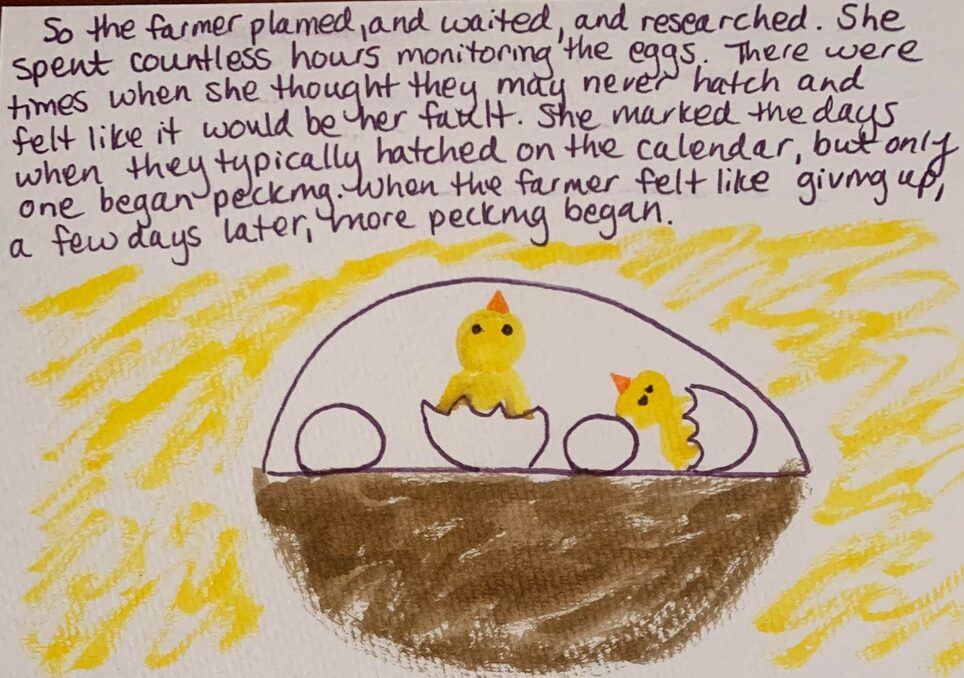
Image description: Chicks hatching from eggs within an incubator in front of a yellow background. Handwritten text reads, so the farmer planned, and waited, and researched. She spent countless hours monitoring the eggs. There were times when she thought they may never hatch and felt like it would be her fault. She marked the days when they typically hatched on the calendar, but only one began pecking. When the farmer felt like giving up, a few days later, more pecking began.
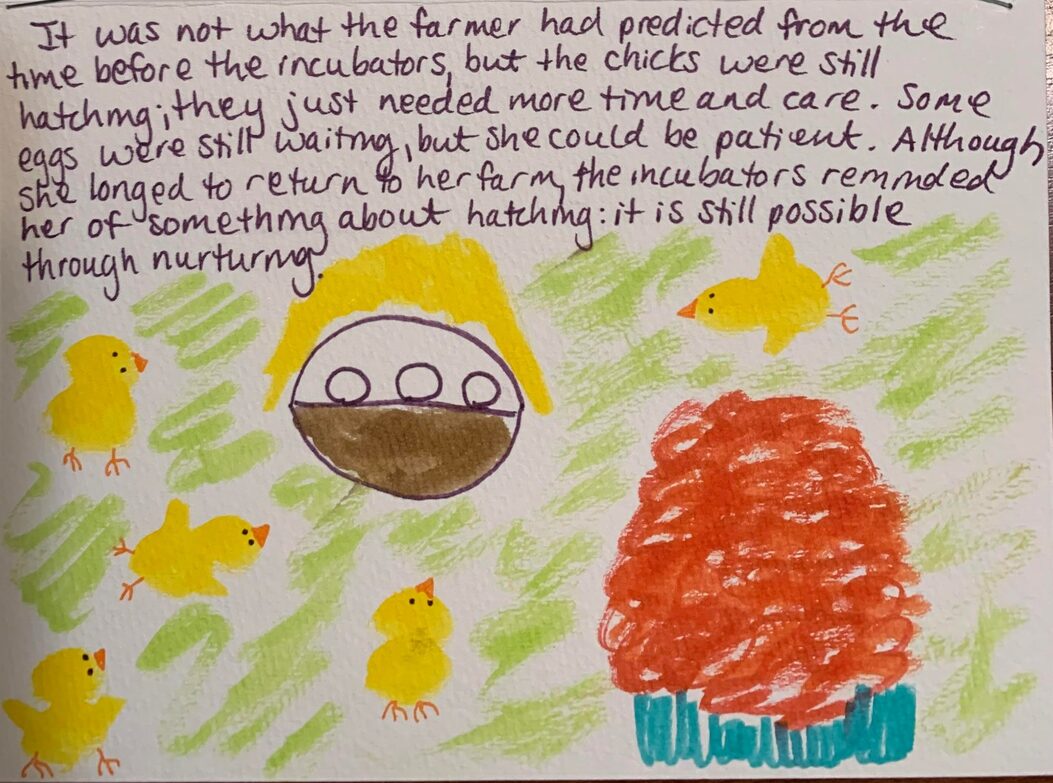
Image description: Human figure with long red hair and back towards the reader staring at baby chicks surrounding an incubator with more eggs inside in front of a green background. Handwritten text reads, it was not what the farmer had predicted from the time before the incubators, but the chicks were still hatching; they just needed more time and care. Some eggs were still waiting, but she could be patient. Although she longed to return to her farm, the incubators reminded her of something about hatching: it is still possible through nurturing.
After I created my metaphor, I thought that the overall theme was positive. I regained confidence in my teaching and was able to find a way to support my students. But there were also details that I did not notice until after I completed the metaphor. As Berthoff (1981) explains, meanings occur when we create them, but also can change when we think about them. The image representing me never faces the front for viewers to see her face. Looking back on my time teaching online, this was an appropriate stylistic choice; I never wanted my students or colleagues to see my emotions, instead keeping my struggles private. The dark background in the image with all of the incubators and the question mark to represent my image’s thoughts is a reflection of extremely dark uncertainty that I was facing when forced to move my courses online. But my eyes are always drawn to the vibrantly yellow chicks, or students, that, by the end of the story, are moving around freely again outdoors. I was hopeful that there would be a return to the “farm,” or in-person learning, but I was also appreciative that through time and care, “hatching,” or learning, could still occur in what I viewed as unnatural spaces for growth/education. Still, educators deserve care as well, and although I felt isolated during remote teaching, I found a way to care for myself through metaphorical expression of my experiences.
Bio
Peaches Hash, Ed.S., Ed.D., is a lecturer of Rhetoric and Writing Studies within Appalachian State University’s Department of English. She also teaches AP courses for Johns Hopkins University’s Center for Talented Youth. Some of her recent publications can be found in English Journal, Journal of Curriculum and Pedagogy, and Teaching English in the Two-Year College.
